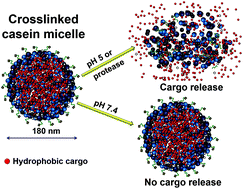Crosslinked casein-based micelles as a dually responsive drug delivery system†
Abstract
New types of biodegradable nanocarriers for drug delivery were prepared using casein (CAS) micelles as particle templates and glyceraldehyde (GAL) as a crosslinking agent. We found that highly crosslinked casein micelles (CCM) maintained their structural integrity at pH 7.4 (plasma conditions) but were easily degraded in the presence of proteases at pH 5 (lysosomal conditions). Nile red (NR) was chosen as a hydrophobic model drug inspired by the natural role of casein as lipophilic nutrient nanotransporter. The cumulative release of the NR-loaded micelles showed marginal dye leakage at pH 7.4 but was significantly accelerated by protease and pH-mediated degradation of the nanocarriers in a dual-responsive fashion. The prepared nanocarriers possess many favorable features for drug delivery: excellent biocompatibility and biodegradability, high stability in physiological conditions, remarkable capacity for the encapsulation of hydrophobic drugs, minimal drug leakage under extracellular conditions, and rapid drug release in response to the endo-lysosomal levels of pH and proteases. In this regard, the prepared CCM represent a promising candidate for the delivery and triggered release of anti-cancer drugs in lysosomal environments.



 Please wait while we load your content...
Please wait while we load your content...